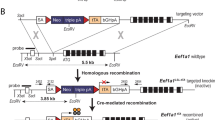Abstract
The transcription factor CCAAT/enhancer binding protein (C/EBP)β is critical for normal growth and differentiation of the mammary gland. The intronless C/EBPβ gene encodes a single mRNA that produces three protein isoforms, C/EBPβ-1, -2, and -3, which share a common basic-leucine zipper domain at their C-terminus, but are distinguished at their N-termini by the in-frame methionine codon used to initiate translation. Although C/EBPβ-1 and -2 are both transactivators, they likely perform distinct functions in mammary epithelial cells. C/EBPβ-1 is the only isoform detected in normal human mammary tissue. In breast cancer cell lines, C/EBPβ-1 is absent, and the C/EBPβ-2 transactivator is expressed. Moreover, our data suggest that C/EBPβ-2 is upregulated in human primary breast tumors. To assess C/EBPβ-2′s ability to participate in the transformation process, we generated recombinant retrovirus selectively encoding epitope-tagged C/EBPβ-2. Strikingly, 10 days after infecting a normal human mammary epithelial cell line (MCF10A) with C/EBPβ-2 virus, transformed subcultures were readily generated. Specifically, C/EBPβ-2-overexpressing MCF10A cells form foci, gain anchorage independence, express markers associated with having undergone an epithelial-to-mesenchymal transition, and acquire an invasive phenotype. These studies, and our previous observations, provide supportive evidence that deregulated expression of C/EBPβ-2 contributes to malignant conversion of the human breast.
This is a preview of subscription content, access via your institution
Access options
Subscribe to this journal
Receive 50 print issues and online access
$259.00 per year
only $5.18 per issue
Buy this article
- Purchase on Springer Link
- Instant access to full article PDF
Prices may be subject to local taxes which are calculated during checkout









Similar content being viewed by others
References
Baer M and Johnson PF . (2000). J. Biol. Chem., 275, 26582–26590.
Bartkova J, Lukas J, Muller H, Lutzhoft D, Strauss M and Bartek J . (1994). Int. J. Cancer, 57, 353–361.
Buck M, Poli V, Hunter T and Chojkier M . (2001). Mol. Cell, 8, 807–816.
Buck M, Poli V, van der Geer P, Chojkier M and Hunter T . (1999). Mol. Cell, 4, 1087–1092.
Buckley MF, Sweeney KJ, Hamilton JA, Sini RL, Manning DL, Nicholson RI, deFazio A, Watts CK, Musgrove EA and Sutherland RL . (1993). Oncogene, 8, 2127–2133.
Caivano M, Gorgoni B, Cohen P and Poli V . (2001). J. Biol. Chem., 276, 48693–48701.
Calkhoven CF, Muller C and Leutz A . (2000). Genes Dev., 14, 1920–1932.
Danen EH and Yamada KM . (2001). J. Cell Physiol., 189, 1–13.
Descombes P and Schibler U . (1991). Cell, 67, 569–579.
Eaton EM, Hanlon M, Bundy L and Sealy L . (2001). J. Cell Physiol., 189, 91–105.
Fantl V, Edwards PA, Steel JH, Vonderhaar BK and Dickson C . (1999). Dev. Biol., 212, 1–11.
Fantl V, Stamp G, Andrews A, Rosewell I and Dickson C . (1995). Genes Dev., 9, 2364–2372.
Gilles C and Thompson E . (1996). Breast J., 2, 83–96.
Gorgoni B, Caivano M, Arizmendi C and Poli V . (2001). J. Biol. Chem., 276, 40769–40777.
Grignani F, Kinsella T, Mencarelli A, Valtieri M, Riganelli D, Lanfrancone L, Peschle C, Nolan GP and Pelicci PG . (1998). Cancer Res., 58, 14–19.
Half E, Tang XM, Gwyn K, Sahin A, Wathen K and Sinicrope FA . (2002). Cancer Res., 62, 1676–1681.
Hanlon M, Bundy LM and Sealy L . (2000). BMC Cell Biol., 1, 2.
Hay ED . (1995). Acta Anat., 154, 8–20.
Hirai Y, Radisky D, Boudreau R, Simian M, Stevens ME, Oka Y, Takebe K, Niwa S and Bissell MJ . (2001). J. Cell Biol., 153, 785–794.
Kim Y and Fischer SM . (1998). J. Biol. Chem., 273, 27686–27694.
Kinsella TM and Nolan GP . (1996). Hum. Gene Ther., 7, 1405–1413.
Kowenz-Leutz E and Leutz A . (1999). Mol. Cell, 4, 735–743.
Liu CH, Chang SH, Narko K, Trifan OC, Wu MT, Smith E, Haudenschild C, Lane TF and Hla T . (2001). J. Biol. Chem., 276, 18563–18569.
Lochter A, Galosy S, Muschler J, Freedman N, Werb Z and Bissell MJ . (1997a). J. Cell Biol., 139, 1861–1872.
Lochter A, Srebrow A, Sympson CJ, Terracio N, Werb Z and Bissell MJ . (1997b). J. Biol. Chem., 272, 5007–5015.
Montell DC . (2001). Mech. Dev., 105, 19–25.
Raught B, Gingras AC, James A, Medina D, Sonenberg N and Rosen JM . (1996). Cancer Res., 56, 4382–4386.
Reddy ST, Wadleigh DJ and Herschman HR . (2000). J. Biol. Chem., 275, 3107–3113.
Robinson GW, Johnson PF, Hennighausen L and Sterneck E . (1998). Genes Dev., 12, 1907–1916.
Seagroves TN, Krnacik S, Raught B, Gay J, Burgess-Beusse B, Darlington GJ and Rosen JM . (1998). Genes Dev., 12, 1917–1928.
Sears RC and Sealy L . (1994). Mol. Cell Biol., 14, 4855–4871.
Sicinski P, Donaher JL, Parker SB, Li T, Fazeli A, Gardner H, Haslam SZ, Bronson RT, Elledge SJ and Weinberg RA . (1995). Cell, 82, 621–630.
Sommers CL, Heckford SE, Skerker JM, Worland P, Torri JA, Thompson EW, Byers SW and Gelmann EP . (1992). Cancer Res., 52, 5190–5197.
Sommers CL, Walker-Jones D, Heckford SE, Worland P, Valverius E, Clark R, McCormick F, Stampfer M, Abularach S, Gelmann EP . (1989). Cancer Res., 49, 4258–4263.
Soule HD, Maloney TM, Wolman SR, Peterson Jr WD, Brenz R, McGrath CM, Russo J, Pauley RJ, Jones RF and Brooks SC . (1990). Cancer Res., 50, 6075–6086.
Tait L, Soule HD and Russo J . (1990). Cancer Res., 50, 6087–6094.
Thomas B, Berenbaum F, Humbert L, Bian H, Bereziat G, Crofford L and Olivier JL . (2000). Eur. J. Biochem., 267, 6798–6809.
Thompson EW, Paik S, Brunner N, Sommers CL, Zugmaier G, Clarke R, Shima TB, Torri J, Donahue S, Lippman ME, Martin GR and Dickson RB . (1992). J. Cell Physiol., 150, 534–544.
Timchenko NA, Welm AL, Lu X and Timchenko LT . (1999). Nucleic Acids Res., 27, 4517–4525.
Wadleigh DJ, Reddy ST, Kopp E, Ghosh S and Herschman HR . (2000). J. Biol. Chem., 275, 6259–6266.
Wang TC, Cardiff RD, Zukerberg L, Lees E, Arnold A and Schmidt EV . (1994). Nature, 369, 669–671.
Wardlaw SA, Zhang N and Belinsky SA . (2002). Mol. Pharmacol., 62, 326–333.
Xiong W, Hsieh CC, Kurtz AJ, Rabek JP and Papaconstantinou J . (2001). Nucleic Acids Res., 29, 3087–3098.
Yu Q, Geng Y and Sicinski P . (2001). Nature, 411, 1017–1021.
Yuan CJ, Mandal AK, Zhang Z and Mukherjee AB . (2000). Cancer Res., 60, 1084–1091.
Zahnow CA, Cardiff RD, Laucirica R, Medina D and Rosen JM . (2001). Cancer Res., 61, 261–269.
Zahnow CA, Younes P, Laucirica R and Rosen JM . (1997) J. Natl. Cancer Inst., 89, 1887–1891.
Zajchowski DA, Bartholdi MF, Gong Y, Webster L, Liu HL, Munishkin A, Beauheim C, Harvey S, Ethier SP and Johnson PH . (2001). Cancer Res., 61, 5168–5178.
Zhu S, Yoon K, Sterneck E, Johnson PF and Smart RC . (2002). Proc. Natl. Acad. Sci. USA, 99, 207–212.
Acknowledgements
The authors are indebted to Katie Tipton for technical assistance. We thank Erin Eaton and Mary Hanlon for their insightful comments and careful reading of the manuscript. We are grateful for the generous gifts of the LZRS-BMN-lacZ retroviral vector and Phoenix cells from Gary Nolan (Stanford University), and vimentin antibody from Al Reynolds (Vanderbilt). We also thank William Russell, and Carlos Arteaga and his lab members for generously sharing their equipment to generate the phase contrast microscopic images. The fluorescent images from confocal and epifluorescent microscopy were acquired through the use of the VUMC Cell Imaging Core Resource (supported by NIH Grants CA68485 and DK20593) with technical assistance provided by Jonathan Sheehan and Sam Wells. Statistical analysis was carried out by Yu Shyr through the use of the VICC Biostatistics Shared Resource (supported by NCI Grant P30 CA68485).
Author information
Authors and Affiliations
Corresponding author
Rights and permissions
About this article
Cite this article
Bundy, L., Sealy, L. CCAAT/enhancer binding protein beta (C/EBPβ)-2 transforms normal mammary epithelial cells and induces epithelial to mesenchymal transition in culture. Oncogene 22, 869–883 (2003). https://doi.org/10.1038/sj.onc.1206216
Published:
Issue Date:
DOI: https://doi.org/10.1038/sj.onc.1206216
Keywords
This article is cited by
-
C/EBPβ isoform-specific regulation of migration and invasion in triple-negative breast cancer cells
npj Breast Cancer (2022)
-
C/EBPß Isoform Specific Gene Regulation: It’s a Lot more Complicated than you Think!
Journal of Mammary Gland Biology and Neoplasia (2020)
-
C/EBPβ deletion in oncogenic Ras skin tumors is a synthetic lethal event
Cell Death & Disease (2018)
-
Transcription factor C/EBP-β induces tumor-suppressor phosphatase PHLPP2 through repression of the miR-17–92 cluster in differentiating AML cells
Cell Death & Differentiation (2016)
-
C/EBPβ regulates homeostatic and oncogenic gastric cell proliferation
Journal of Molecular Medicine (2016)



